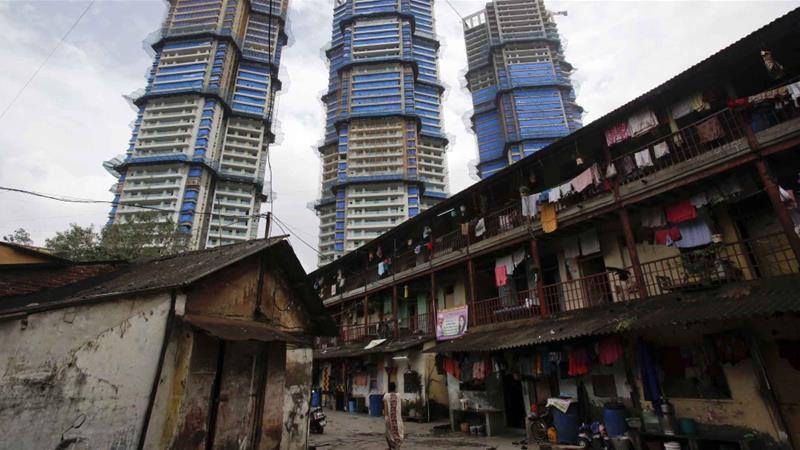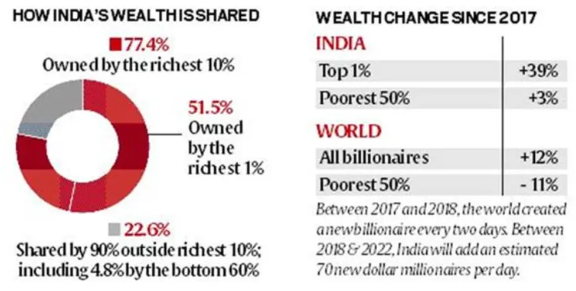Rising income inequality in India
2020 FEB 17
Mains >
Economic Development > Indian Economy and issues > Inclusive growth

WHY IN NEWS?
Rights group Oxfam in its study 'Time to Care' has said that there is severe economic disparity between the rich and poor in India.
NUMBERS SPEAK THE REALITY:
- The top 10% of the Indian population holds 77% of the total national wealth.
- India's richest 1 % hold more than four-times the wealth held by the bottom 70 % of the population.
- 63 million Indians are pushed into poverty because of healthcare costs every year.

REASONS FOR GROWING INEQUALITY:
- Skewed regional growth:
- In India, growth continues to be focused on urban centers. The trickle-down theory in regional growth, which was proposed after independence, has largely failed to attain the desired objectives.
- Skewed economic growth:
- A considerable share of economic growth was cornered by the service sector that employed nearly a third of the population. On the contrary, agriculture grew at less than 3 % in the last few decades.
- Focus on capital intensive economic growth rather than labour intensive growth is also a contributing factor to the rising inequality.
- Flawed tax collection system:
- Oxfam said governments are massively under-taxing the wealthiest individuals and corporations and failing to collect revenues that could help lift the responsibility of care from women and tackle poverty and inequality.
- Predominance of informal economy:
- In India, nearly 90% of the economy is informal in nature. The lack of regulatory control over this sector means that issues like labour exploitation, low income levels and lack of social security is rampant.
- The informal nature of economy is a major reason for the persistence of poverty in India.
.png)
- Underfunded public services:
- Despite having numerous schemes and measures, facilities for the common man remains underfunded. This is severe in the healthcare and education sector, where the public spending stands at a dismal 1.4% and 3% of GDP respectively.
- The high cost of healthcare is a major contributing factor to the vicious cycle of poverty.
- Gender discriminations:
- Women continue to take the backstage even in today’s economy. Besides this, the governments are also underfunding vital public services and infrastructure that could help reduce women and girls’ workload, the report said.
- Lack of entrepreneurship and employable skills:
- Despite having the largest human capital, unemployment continues to be a major issue in India. The lack of entrepreneurship and slow employment generation
SOME CONSEQUENCES OF INEQUALITY:
- Social stratification: Lack of upward mobility and drastic economic slowdown has only exacerbated existing societal tensions.
- Social unrests: a growing sense of unfairness, precarity, perceived loss of identity and dignity, weakening social fabric, eroding trust in institutions, disenchantment with political processes, and an erosion of the social contract. The clamor for reservations, statehood, caste violence etc. can be seen as symptoms of this.
- Poor socio-economic health: Poor development indicators like IMR, MMR, low per capita income, lower education and learning outcomes at schools, high rate of population growth can be traced to existing socio-economic inequalities.
- Poor social outcomes: High economic inequality is detrimental to public healthcare and education. This will perpetuate into further division of the society.
GOVERNMENT INITIATIVES:
FISCAL MEASURES:
- Taxation:
- India follows a progressive taxation system, where the tax rate increases as the taxable amount increases. Eg: The income tax has different slabs, where the rates increase as the income increases.
- Subsidies:
- India provides subsidies for numerous items used by common man, such as food grains, agricultural inputs and fuel, all of which are aimed at attaining social justice.
- Measures to prevent illegal amassment of wealth:
- Legislative and institutional measures such as Prevention of Money Laundering Act, Benami Transaction (Prohibition) Act and establishment Enforcement Directorate has been done to prevent illegal accumulation of wealth in the country.
SOCIAL SERVICES:
- Reservation system:
- The constitution provides for reservation in education and jobs for the most vulnerable sections of the society with the aim of attaining social justice.
- Insurance schemes:
- The government has undertaken numerous efforts to enhance the insurance coverage in India. Some of these include Sampoorna Bima yojana, Pradhan Manthri Jeevan Jyothi Bima Yojana, Aam aadmi Bima yojana and Ayushman Bharat scheme.
- Public healthcare and education facilities:
- Government operates numerous hospitals and educational institutions that provides services either free of cost or at a nominal cost, so as to ensure affordability and accessibility to basic services.
- It has also launched targeted initiatives like National Health Policy 2017, Integrated Child Development Scheme, Sarva Shikhsa Abhiyan and maternity benefits schemes.
- Public Distribution System:
- The Indian government operates one of the largest food supply networks in the world. It provides food grains and essential commodities at subsidized prices to the most vulnerable sections of people.
HUMAN CAPITAL DEVELOPMENT MEASURES:
- Skill India Mission:
- Skill India Mission was launched with an aim to train over 40 crore people in India in different skills by 2022.
- It includes various initiatives of the government like “National Skill Development Mission”, “Pradhan Mantri Kaushal Vikas Yojana (PMKVY)” and the “Skill Loan scheme”.
- Pradhan Mantri Kaushal Vikas Yojana:
- It is an outcome-based skill certification scheme implemented by National Skill Development Corporation (NSDC).
- The objective is to enable Indian youths to take up industry-relevant skill training that will help them in securing a better livelihood.
- The various components are short term training, recognition of prior learning, special projects, Kaushal and Rozgarmela, placement guidelines and monitoring guidelines.
- Start Up India Scheme:
- It aims at fostering entrepreneurship and promoting innovation by creating a conducive ecosystem Start-ups.
- It does the same through self-certification schemes, single point clearances, easy patenting system, legal and financial supports.
- Make in India:
- Make in India is a new national program designed to transform India into a global manufacturing hub. The focus of the programme is on creating jobs and skill enhancement in 25 sectors.
WAY FORWARD:
- The report states that by increasing social spending, changing gendered attitudes towards care work, and ensuring the wealthy pay their share, we could take concrete action towards this goal.
- Improving the state of Agriculture essential as half of the population relies on agriculture for their sustenance. The need is to make farming more remunerative by improving productivity and reducing input cost. This can be attained by investing in irrigation technologies, MSP reforms, improving market accessibility through platforms like e-Rashtriya Kisan Agri Mandi etc. and to promote research to improve farm productivity.
- In the industrial sector, focus must be on labour intensive industries. As suggested by NITI Ayog, promoting Labour intensive industries such as leather and apparel, can be instrumental in raising incomes of the bottom 50%.
- Public sector spending in critical social sectors such as health and education needs to be improved to globally recommended levels.
- India needs to improve tax to GDP ratio and bring it on par with emerging economies. This can be done by lowering income tax threshold, preventing tax evasion, simplifying tax procedures and campaigning to inculcate a habit of tax paying.
- In this regard, India should also prospect the potentials of developing a universal basic income scheme (UBI), as was suggested by the economic survey 2016-’17.
Practice Question
Q. Rising income inequality in the country is a matter that requires serious attention. Discuss?


.png)